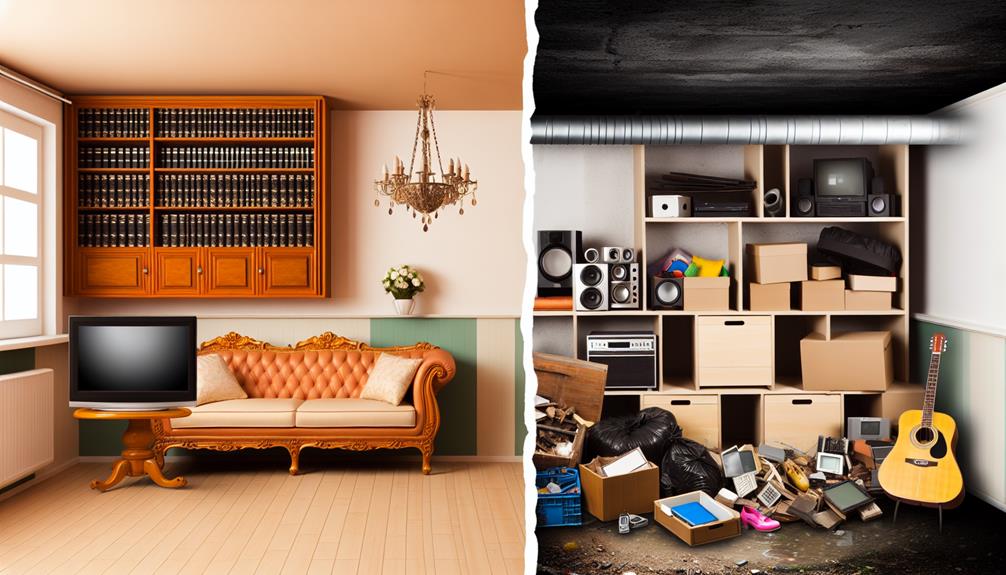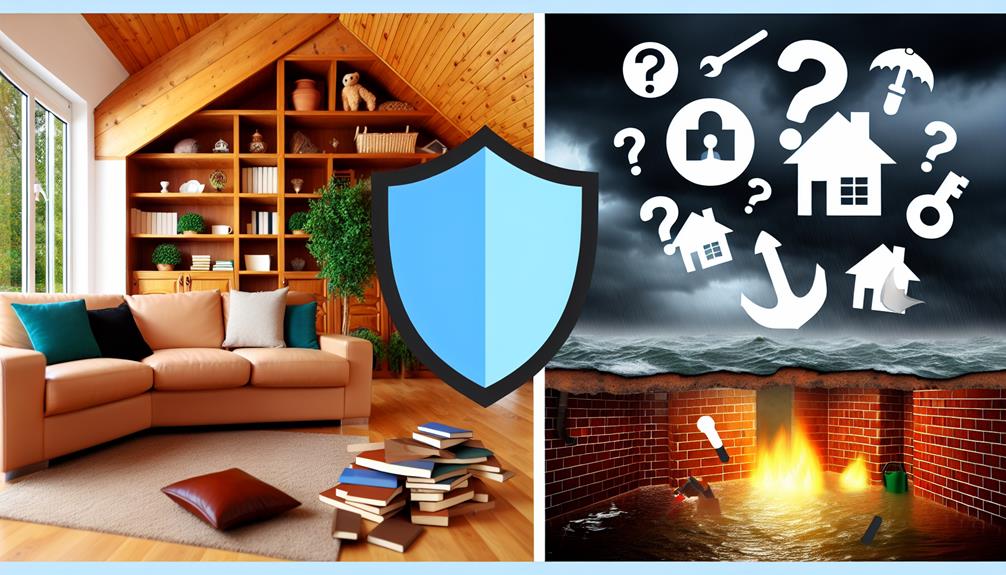When you think about home insurance, it's easy to assume it covers everything related to your property, but that's not always the case. A typical policy offers essential protections like dwelling coverage, personal property coverage, and liability protection, yet it often has significant exclusions. Understanding what's included and what's left out is vital for safeguarding your investment. What you might not realize is how these limitations can impact you when you need it most. Curious about how to navigate these complexities and what options might be available to you?
Key Takeaways
- Dwelling protection covers the home structure from perils like fire, theft, and vandalism.
- Personal property coverage protects belongings inside the home, typically covering 50-70% of dwelling coverage.
- Personal liability coverage offers financial protection against legal claims for bodily injury or property damage on the insured property.
- Medical payments coverage pays for guest injuries on the property, excluding intentional harm.
- Additional living expenses coverage helps cover temporary housing costs if the home becomes uninhabitable.
Overview of Home Insurance Coverage
What does a typical homeowners insurance policy cover? When you look at standard homeowners insurance policies, you'll find essential coverage for your home and belongings. The most significant part of this coverage is dwelling protection, which safeguards your home's physical structure from various covered perils like fire, theft, and vandalism. Personal property coverage comes into play, ensuring that your valuable items—like furniture and electronics—are protected, usually at 50-70% of your dwelling coverage amount.
Additionally, liability coverage is vital. It offers financial protection against legal claims for bodily injury or property damage that occurs on your property. Most policies start with limits around $100,000, but you can adjust these based on your needs.
If your home becomes uninhabitable due to a covered loss, Additional Living Expenses (ALE) coverage steps in, covering temporary housing costs and other living expenses, generally set at about 20% of your dwelling coverage. Remember, though, that a standard homeowners insurance policy typically excludes certain perils, such as floods and earthquakes, which may require separate policies from your insurance company for full protection.
Types of Coverage
Understanding the various types of coverage in a homeowners insurance policy is essential for ensuring your home and belongings are adequately protected. Each type offers different benefits, helping you navigate potential risks.
| Coverage Type | Description | Typical Coverage Amount |
|---|---|---|
| Dwelling Coverage | Protects the physical structure from covered perils like fire and wind, based on rebuild cost. | Replacement cost coverage based on home value. |
| Other Structures Coverage | Insures detached buildings like fences and sheds. | Usually 10% of dwelling coverage amount. |
| Personal Property Coverage | Safeguards personal belongings within the home, covering damages or losses. | Typically 50-70% of dwelling coverage amount. |
| Personal Liability Coverage | Offers financial protection against lawsuits for bodily injury or property damage to others. | Limits generally range from $100,000 to $500,000. |
| Medical Payments Coverage | Assists with medical expenses for injuries to guests on your property, regardless of fault. | Coverage for guest injuries, excluding intentional harm. |
Having a clear understanding of these homeowners insurance coverage types will help you choose the right policy for your needs.
Coverage Limits and Exclusions

Homeowners insurance policies come with specific coverage limits and exclusions that can affect your financial protection. Typically, the coverage limits for personal property range from 50% to 70% of your dwelling coverage amount. It's vital to assess your belongings to guarantee you have adequate protection. Be aware that common exclusions include flood damage, earthquake damage, wear and tear, and pest-related damage, which might require separate insurance policies.
When it comes to high-value items like jewelry or fine art, these often have specific dollar limits within your personal property coverage. To fully protect these assets, consider adding endorsements to your policy. Liability coverage limits usually start around $100,000, but you might want to increase this limit to safeguard your assets against potential lawsuits.
Understanding these exclusions and limitations is imperative, as they can greatly impact the coverage you receive during a claim. If you're not aware of these aspects, you may find yourself underinsured when you need help the most. Always review your homeowners insurance policy closely to guarantee you're adequately covered for both your personal property and liability needs.
Replacement Cost Vs. Actual Cash Value
When it comes to protecting your belongings, knowing the difference between Replacement Cost Value (RCV) and Actual Cash Value (ACV) is vital. RCV policies cover the full cost to replace damaged items without factoring in depreciation, meaning you can buy new items at current market prices. In contrast, ACV policies deduct depreciation, resulting in lower payouts.
Consider the emotional impact of your choice:
- Losing cherished items can be devastating.
- Settling for less might not bring back your peace of mind.
- Securing financial protection is vital for your future stability.
While RCV policies typically cost 10-15% more than ACV policies, they offer better financial protection when you need it most. Factors like labor and material costs, along with housing demand and inflation, influence rebuilding costs under RCV, affecting your total payout.
When evaluating your homeowners insurance policy, think about your needs. RCV is particularly important for essential items to guarantee adequate coverage against potential losses. Making the right choice can safeguard not just your belongings, but also your financial well-being.
Claims Process and Costs

Managing the claims process can feel overwhelming, especially after experiencing a loss. Understanding how your homeowners insurance policy works can help make this easier. The duration of the claims process can range from weeks to years, depending on the complexity of your claim. Catastrophe claims often settle within weeks to six months, while rebuilding a home after a major disaster may take 18-24 months.
To give you a clearer picture of the potential costs and reimbursements, here's a breakdown:
| Claim Type | Average Cost/Amount | Notes |
|---|---|---|
| Building Costs | $80 per square foot | Influences reimbursement |
| Home Value | $400,000 | Affects personal belongings |
| Personal Belongings | $200,000 – $280,000 | Covers 50%-70% of home value |
| Loss of Use Coverage | Varies by situation | Temporary housing costs |
| Medical Payments | Up to policy limit | Covers injuries on property |
Regularly reviewing your coverage limits guarantees they align with your current needs, helping you effectively compare quotes and get the best rates.
Additional Coverage Options
Exploring additional coverage options can greatly enhance your homeowners insurance policy, ensuring you're adequately protected against various risks. While standard policies cover many essentials, these extra options can provide peace of mind for specific concerns.
Consider these important additional coverage options:
- Water backup coverage: Protects against damages from sewer backups, often excluded in standard policies.
- Ordinance or law coverage: Covers costs to rebuild or repair your home to meet updated building codes after a loss.
- Identity theft insurance: Helps with expenses related to recovering from identity theft, including legal fees and lost wages.
If you own high-value items like jewelry or art, you might need endorsements to secure them beyond standard personal property coverage. Additionally, umbrella policies offer extra liability protection, safeguarding your assets from significant claims or lawsuits that could arise.
Common Misconceptions About Home Insurance

Understanding your homeowners insurance policy can be challenging, especially with the many misconceptions that circulate. One common myth is that home insurance policies cover all types of damage. In reality, insurance typically covers specific perils, and natural disasters like floods and earthquakes often require separate policies.
You might also think personal property coverage protects all belongings equally, but high-value items like jewelry or artwork usually have limited coverage and may need additional endorsements. Another misconception is about liability coverage; it generally only applies to injuries or damages occurring on your property and has exclusions for certain breeds of pets.
Many homeowners mistakenly believe their insurance premiums are tax-deductible, but this only applies to rental properties, not primary residences. Additionally, some assume all repairs are covered, yet routine maintenance issues and wear and tear are typically excluded from coverage.
Being aware of these misconceptions can help you better understand what your home insurance policy actually covers, ensuring you're adequately protected against unexpected events. Always review your policy details to avoid surprises when you need to file a claim.
Frequently Asked Questions
What Are the 4 Main Coverages in a Homeowners Insurance Policy?
In a homeowners insurance policy, you'll find four main coverages. First, there's dwelling coverage, which protects your home's structure. Then, personal property coverage safeguards your belongings inside. You'll also get liability protection, covering you against claims for injuries or damages to others. Finally, additional living expenses (ALE) coverage helps with temporary housing costs if your home becomes uninhabitable due to a covered event. Each coverage has specific limits, so review them carefully.
What Does a Typical Property Insurance Policy Cover?
A typical property insurance policy's like a safety net, catching you when unexpected events happen. It usually covers your home's structure, protecting it from perils like fire and theft. You'll find personal property coverage for your belongings, along with liability protection for accidents that might occur on your property. Plus, if you need temporary housing due to damage, additional living expenses coverage can help ease the burden while you get back on your feet.
What Is the Most Common Home Insurance Policy?
The most common home insurance policy is the HO-3, and it offers broad protection for your dwelling and personal belongings. It covers various perils like fire, theft, and vandalism, but excludes specific risks such as floods and earthquakes. You'll also get liability coverage, which helps if someone gets injured on your property. Plus, if your home becomes uninhabitable, it covers additional living expenses, ensuring you're not left without a place to stay.
What Coverage Under a Homeowners Policy Would Cover?
When you're looking at homeowners insurance, you'll find coverage for your dwelling, personal belongings, liability, additional living expenses, and medical payments. Dwelling coverage shields the structure from damage, while personal property coverage protects your valuables inside. Liability coverage defends against lawsuits, and additional living expenses cover temporary housing if your home's uninhabitable. Medical payments help with injuries sustained by others on your property. These elements work together to keep you financially secure.
